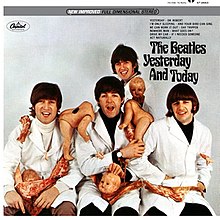Yesterday and Today
| Yesterday and Today | ||||||||
|---|---|---|---|---|---|---|---|---|
 |
||||||||
| Studio album by The Beatles | ||||||||
| Released | 20 June 1966 | |||||||
| Recorded | 1965–66 | |||||||
| Studio | EMI Studios, London | |||||||
| Genre | Rock, psychedelic rock, folk rock | |||||||
| Length | 27:33 | |||||||
| Label | Capitol | |||||||
| Producer | George Martin | |||||||
| The Beatles North American chronology | ||||||||
|
||||||||
| Professional ratings | |
|---|---|
| Review scores | |
| Source | Rating |
| AllMusic | |
| Encyclopedia of Popular Music | |
| The Rolling Stone Album Guide | |
Yesterday and Today is the ninth Capitol Records album release by the Beatles and the eleventh overall American release. It was originally issued only in the United States and Canada. In the 1970s it was issued in Japan. A later UK release (on Compact Disc) followed in 2014. The album is remembered primarily for the controversy surrounding its original cover image, the "butcher cover" featuring the band dressed in white smocks and covered with decapitated baby dolls and pieces of meat. The album's title is based on the song "Yesterday". Early album cover proofs show the word "Yesterday" in quotes.
Yesterday and Today included tracks from the Beatles' two most recent British LPs which had not yet been included on American albums, plus three from their upcoming LP in the United Kingdom, plus two songs which were back-to-back on a single:
The hodge-podge nature in which Capitol Records compiled their albums irritated the group, who felt they had "put a lot of work into the sequencing" of the British versions.
Released on 20 June 1966, the Yesterday and Today album's controversial cover (see section below) marked the first time the Beatles' judgement was criticised by the media and distributors. After advance copies were sent to disc jockeys and record reviewers, negative reaction to the cover photo was so strong Capitol recalled 750,000 copies from distributors to replace the cover. The total cost to Capitol to replace the cover and promotional materials was $250,000, wiping out their initial profit. Nevertheless, the album reached #1 on the US Billboard charts by 30 July 1966 and certified gold soon after. It stayed at number one for five weeks.
On 25 March 1966, photographer Robert Whitaker had the Beatles in the studio for a conceptual art piece titled A Somnambulant Adventure. For the shoot, Whitaker took a series of pictures of the group dressed in butcher smocks and draped with pieces of meat and body parts from plastic baby dolls. The group played along as they were tired of the usual photo shoots—Lennon recalled the band having "boredom and resentment at having to do another photo session and another Beatles thing"—and the concept was compatible with their own black humour. Although not originally intended as an album cover, the Beatles submitted photographs from the session for their promotional materials. According to a 2002 interview published in Mojo, former Capitol president Alan W. Livingston stated that it was Paul McCartney who pushed strongly for the photo's inclusion as the album cover, and that McCartney reportedly described it as "our comment on the [Vietnam] war". A photograph of the band smiling amid the mock carnage was used as promotional advertisements for the British release of the "Paperback Writer" single. A similar photograph from this shoot was used for the cover of the 11 June 1966 edition of the British music magazine Disc.
...
Wikipedia

